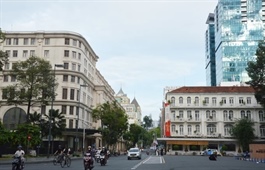Economist and housing market insiders remain cautiously optimistic
Economist and housing market insiders remain cautiously optimistic
In 2024, the number of real estate businesses returning to the market surged, while the number of dissolved enterprises dropped significantly, showing the real estate sector has regained stability.

Caution, however, is advised as deeply rooted issues can derail progress, said economists and industry insiders.
Recovery
A report recently published by the General Statistics Office (GSO) showed in 2024, the number of real estate businesses resuming operations exceeded 3,227, an increase of 42.2 per cent compared to 2023 (approximately 2,300 businesses). The number of dissolved real estate businesses also declined significantly in 2024 with nearly 1,300 real estate companies dissolved.
According to the Vietnam Association of Realtors (VARS), the real estate market in 2024 had passed its most challenging phase, and is now on a path of recovery. In the second half of 2024, the promulgation of the three key laws - the Land Law, Housing Law, and Real Estate Business Law - has a positive effect to the Southeast Asian country’s housing market. This was most evident in the competitive land auctions in the suburban areas of the capital city Hà Nội.
In the fourth quarter of 2024, as the market showed signs of warming, many real estate developers adjusted their plans, launching products earlier than expected with various promotional policies, resulting in housing supply exceeding projections, an exception not seen in recent years.
Risks
However, recovery is not without risks, as lingering structural issues could derail progress, said the association. While the developments in 2024 provided significant momentum for real estate businesses to return to the market, experts have identified several challenges the sector will soon face
The GSO report said alongside the positive trends of businesses resuming operations and reduced dissolutions, the number of newly established enterprises dropped slightly by 2.7 per cent to nearly 4,600. This indicates that investors remain cautious about entering the real estate market.
Châu Quốc Quân, a real estate investor, remarked that the domestic real estate market now resembles China’s market in early 2023, which saw signs of recovery supported by legal and interest rate stimulus policies.
Quân said: “However, after the COVID-19 pandemic, instead of continuing to strengthen measures to fully capitalise on the recovery, China’s support policies proved insufficient, leading to a market downturn. It’s like a patient relying on oxygen when the oxygen is cut off, their condition worsens.”
Meanwhile, VARS said Việt Nam’s real estate market is unlikely to fully recover until all obstacles are addressed and investor confidence returns.
Nguyễn Thế Điệp, deputy chairman of the Hanoi Real Estate Club, said Việt Nam’s real estate market is on an upward trajectory but needs policies and incentives to avoid regression.
“We shouldn’t compare ourselves to developed countries that have had decades of stability and strong businesses," Điệp said.
"In Việt Nam, 95 per cent of businesses are small- and medium-sized, still in a developmental phase, and require policy support to break through. For real estate, it’s just a matter of having resources and the right policies.”
Economist Cấn Văn Lực said recovery has been uneven across segments and regions. Legal obstacles, financial obligations, and rising input costs remain significant challenges for businesses. Meanwhile, housing loan demand has yet to improve due to excessively high property prices, while people’s real incomes remain stagnant.
“Persistently high housing prices could hinder the market's sustainable development,” Lực added.
According to the VARS, by the end of 2024, the primary market recorded approximately 56,000 products offered for sale. Over the entire year, about 81,000 products were introduced, marking a 40 per cent increase compared to 2023.
Market liquidity also improved significantly, with over 47,000 successful transactions recorded during the year, reflecting an absorption rate of 72 per cent with more than 50 per cent of the primary market held by investors.




























